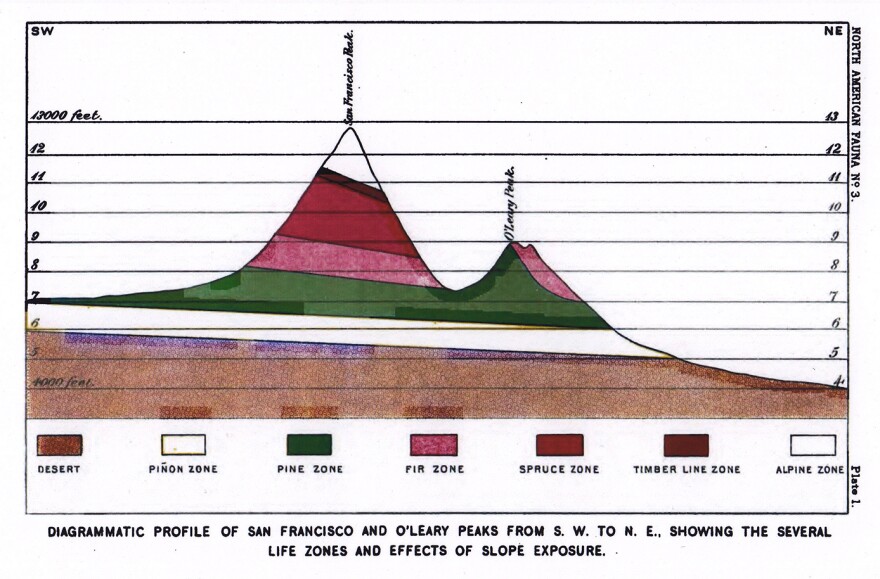A stand of bear-clawed aspen trees on the San Francisco Peaks is the jumping off point for this month’s Canyon Commentary by Scott Thybony. It was the base camp of naturalist C. Hart Merriam in the late 1800’s. He was working on a groundbreaking project: studying the distribution patterns of plants and animals from the bottom of the Grand Canyon to the top of Humphrey’s Peak. Merriam called them ‘Life Zones’, the boundaries which reflect climate and ecological variation in mountains, deserts, rivers and canyons. They are still used today to assess how ecosystems respond to a changing climate.
A short walk brings me to Little Spring at the foot of the San Francisco Peaks where bear-clawed aspens and a stand of Douglas fir enclose an open meadow. In the summer of 1889, C. Hart Merriam made his base camp here and began an ambitious biological survey of the region lying between the Peaks and Grand Canyon. The naturalist was looking forward to a great scientific adventure. It almost became his last.
Merriam and his crew began mapping the distribution of plants and animals occurring at different elevations. He was working out a new theory and needed evidence to confirm his ideas. Riding horseback up the mountain slopes, the director of what would become the U.S. Biological Survey observed how habitats changed, primarily in response to temperature and humidity. He found biotic communities occurring in distinct bands he called life zones. Merriam left his horse at treeline and struggled on foot to reach the summit, but had to turn back exhausted. A second attempt succeeded, and that evening in camp he dined on broiled eagle, a specimen he had collected.

On his first extended trip away from base camp, Merriam led a small party into the Painted Desert. A rainstorm hammered a high mesa to the north on the third day, and despite having camped under clear skies a loud rumbling brought them awake that night. “In a moment,” he wrote, “a great wave of thick mud rushed past with a tremendous roar, accompanied by a fetid stench.” The flood swept down the dry wash, growing to a height of eight feet and burying the spring they depended on. Unable to locate it under a thick layer of mud, they continued the next day as thirst took its toll. The naturalist observed the labored beating of his heart as his blood thickened, and had difficulty recognizing familiar birds due to mirage-like distortions. They struggled for three days before an old Hopi found them close to death. He guided them to a mudhole too dirty for the horses to drink. Merriam and the others drank.
In September he headed to the Grand Canyon. Grabbing a bag of pancakes, the naturalist descended below the rim on the Hance Trail. The steep, punishing descent took its toll on his knee, forcing him to stop at a spring halfway down. At 1:00 in morning he began the trek back to the rim holding a gun in one hand and a skunk he had collected in the other. “The walls were black & often cast heavy shadows across my path,” he wrote. “A hundred times they seemed to meet & shut me in without the possibility of escape. . . The higher I climbed the higher the walls seemed to tower above me. Climbed up about 3,000 feet in the last two miles & had to drag my left leg all the way.”

Members of the survey party went their separate ways on October 1, and Merriam returned to Washington DC to write up his pioneering study. I turn back from Little Spring and notice a bronze plaque marking the site as a national historic landmark. While his life zone theory has been replaced by more sophisticated models, the naturalist had a tremendous influence on our understanding of the interdependence of the natural world.
Scott Thybony's Canyon Commentaries are produced by KNAU, Arizona Public Radio.



